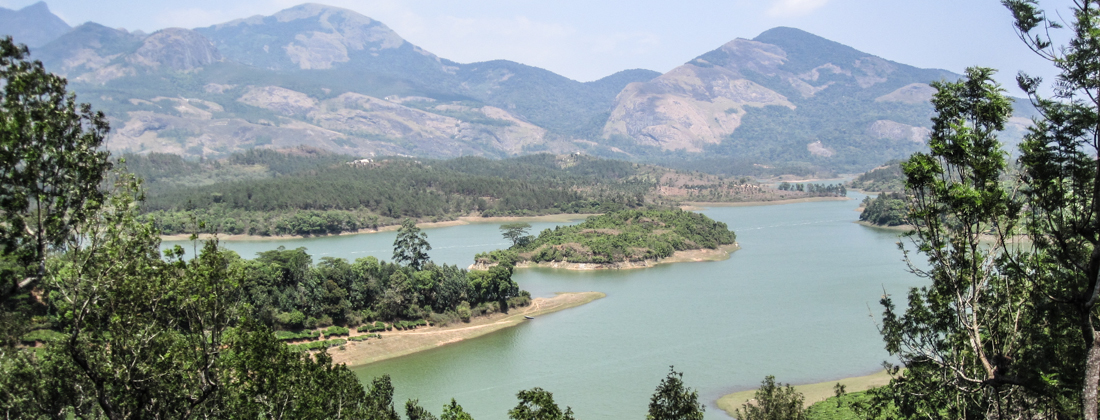
Tamil Nadu and Kerala II
A 12-day adventure trip right across South India
Cultural Highlights – Traditional Spirituality – Spectacular experiences of nature & wildlife
On this 12-day tour of Tamil Nadu and Kerala, you experience the traditional diversity of South India and discover a colorful and vibrant culture between palm trees, rice fields and spice plantations. The journey starts with the World Heritage Site on the sandy beaches of the Coromandel coast and then leads you to the citadel of a picturesque historic fortress. The visit to a traditional ashram gives you an insight into the lively spirituality of the country, while the imposing Dravidian temples help you become familiar with the ritualized world of Hinduism. In the Cardamom mountains, the land where the pepper grows, the spice gardens reveal the secrets of Indian cuisine. When hiking in a wildlife reserve, you will – with a bit of luck – get to see elephants and other wild animals in their natural habitat. A spectacular highlight is the house boat trip through the magical water world of the Kerala backwaters. Finally, you enjoy the idyllic atmosphere of the port city of Kochi and find yourself inspired by the cultural diversity on the Malabar Coast. A varied journey with many impressions!
The proposed itinerary is flexible and can be tailored to your needs in terms of content and schedule. If you’d prefer an extended trip, we can recommend a well-maintained resort in Kerala that offers a stylish natural framework for relaxed days at the beach or rejuvenating Ayurvedic treatment.
Chennai – Mahabalipuram – Gingee – Tiruvannamalai – Gangaikondacholapuram – Thanjavur – Madurai – Thekkady – Backwaters – Cochin
Suggested itinerary:
Day 1: Arrival and transfer to Mahabalipuram
Your trip begins in Chennai, where you will be welcomed at the airport or train station and driven to your hotel in Mahabalipuram. The friendly atmosphere of the beach resort will help ensure that your arrival is a peaceful experience.
Day 2: World Heritage Sites in Mahabalipuram – Transfer to Puducherry (Pondicherry)
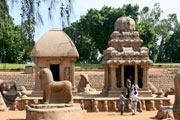 In Mahabalipuram (also called Mamallapuram) one can combine beach fun with a bit of cultural history. Situated directly on the Coromandel coast, the site is regarded as the cradle of South Indian culture and is a true archaeological treasure trove, with masterpieces from the Pallava period (6th – 8th century). In 1985, the monuments were declared a UNESCO World Heritage Site. Attractions include the Monolith temple and the Cave temple, with its magnificent imagery of the gods. It was the first temple in the region constructed from stone blocks. Large reliefs chiseled in granite narrate well known legends of Hindu mythology. The monolithic “Five Rathas” monuments served as architectural models on the basis of which the fundamental elements of Dravidian temple construction were developed. A huge boulder, located on a steep rocky ridge, is known as “Krishna’s Butterball” and presents a popular photo opportunity. Mahabalipuram is also a center of traditional sculpture. Indian statues of the gods in granite, marble and soapstone are still made by hand here in small family businesses. After the tour, a transfer to Puducherry (Pondicherry) follows.
In Mahabalipuram (also called Mamallapuram) one can combine beach fun with a bit of cultural history. Situated directly on the Coromandel coast, the site is regarded as the cradle of South Indian culture and is a true archaeological treasure trove, with masterpieces from the Pallava period (6th – 8th century). In 1985, the monuments were declared a UNESCO World Heritage Site. Attractions include the Monolith temple and the Cave temple, with its magnificent imagery of the gods. It was the first temple in the region constructed from stone blocks. Large reliefs chiseled in granite narrate well known legends of Hindu mythology. The monolithic “Five Rathas” monuments served as architectural models on the basis of which the fundamental elements of Dravidian temple construction were developed. A huge boulder, located on a steep rocky ridge, is known as “Krishna’s Butterball” and presents a popular photo opportunity. Mahabalipuram is also a center of traditional sculpture. Indian statues of the gods in granite, marble and soapstone are still made by hand here in small family businesses. After the tour, a transfer to Puducherry (Pondicherry) follows.
Day 3: Transfer to Tiruvannamalai – Historic Fortress of Gingee – Visit to the ashram of Sri Ramana Maharshi
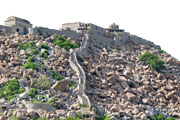 Near the small town of Gingee, on the road to Tiruvannamalai, is a historic fortress that extends across three large hills in a picturesque rocky landscape. A 5 km long fortification wall encloses an area of 7 km² with historic buildings from different eras. The construction of the fortress began in the 13th century during the Chola dynasty. Later, the fort changed hands several times, coming under the control of rulers from the Vijayanagara, Nayak, Bijapur, Maratha and Mogul dynasties. Inside the fort are granaries, barracks, training halls, stables, temples and the remains of a former palace complex. Definitely worth seeing is the Kalyana Mahal with its octagonal tower, built around 1550 in Indo-Saracenic style. The climb to the citadel of the Rajagiri hill is particularly worthwhile because of the wonderful views.
Near the small town of Gingee, on the road to Tiruvannamalai, is a historic fortress that extends across three large hills in a picturesque rocky landscape. A 5 km long fortification wall encloses an area of 7 km² with historic buildings from different eras. The construction of the fortress began in the 13th century during the Chola dynasty. Later, the fort changed hands several times, coming under the control of rulers from the Vijayanagara, Nayak, Bijapur, Maratha and Mogul dynasties. Inside the fort are granaries, barracks, training halls, stables, temples and the remains of a former palace complex. Definitely worth seeing is the Kalyana Mahal with its octagonal tower, built around 1550 in Indo-Saracenic style. The climb to the citadel of the Rajagiri hill is particularly worthwhile because of the wonderful views.
The pilgrimage town of Tiruvannamalai is situated at the foot of the holy Arunachala mountain, which is regarded as a manifestation of Lord Shiva. Ramana Maharshi, one of the most famous masters of Advaita Vedanta in the 20th century, lived at the Arunachala, and his ashram is known worldwide as a major center of Indian spirituality. A visit gives you an insight into the lively spirituality of the country.
Day 4: Places of tranquility on the holy Arunachala mountain – Visit to the great Shiva temple of Tiruvannamalaii
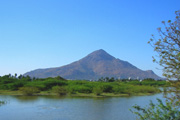 A footpath leads from the ashram to the holy mountain, where two chapels can be found that accommodated the master for many years and which visitors can access during the day for meditation. From the mountain, you have a wonderful view of the city’s Arunachaleshvara temple, where Shiva is worshiped in the form of the Fire element. The temple complex, divided into three courtyards, is among the most famous sanctuaries in Tamil Nadu. The oldest parts of the temple, which was completed in its present form in the 17th century, are typical of the Chola architecture and date back to the 11th century. The white color of the temple towers symbolizes purity. During full moon nights, Tiruvannamalai is a popular place of pilgrimage for several hundred thousand Hindus who, as per traditional practice, walk around the sacred mountain.
A footpath leads from the ashram to the holy mountain, where two chapels can be found that accommodated the master for many years and which visitors can access during the day for meditation. From the mountain, you have a wonderful view of the city’s Arunachaleshvara temple, where Shiva is worshiped in the form of the Fire element. The temple complex, divided into three courtyards, is among the most famous sanctuaries in Tamil Nadu. The oldest parts of the temple, which was completed in its present form in the 17th century, are typical of the Chola architecture and date back to the 11th century. The white color of the temple towers symbolizes purity. During full moon nights, Tiruvannamalai is a popular place of pilgrimage for several hundred thousand Hindus who, as per traditional practice, walk around the sacred mountain.
Day 5: Transfer to Thanjavur – En route visit to Gangaikondacholapuram
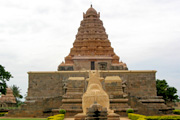 The name Gangaikondacholapuram means “the town of the Chola (ruler) who conquered Ganga”. Here, after a successful military campaign, the Chola ruler Rajendra I established a new capital in the 11th century and erected in its center an elegant, spacious temple complex with a 60 m high structure (Vimana) on top of the main sanctuary. After his death, the city passed into oblivion; the perimeter wall and the entrance tower of the temple were used as a quarry. Today, only the main sanctuary still stands, with its somewhat concavely curved Vimana, in the center of a well kept complex. Niche sculptures of unique elegance attest to the excellent understanding of art during the Chola era and present a broad spectrum of Hindu Gods. The complex has been a UNESCO World Heritage Site since 2004.
The name Gangaikondacholapuram means “the town of the Chola (ruler) who conquered Ganga”. Here, after a successful military campaign, the Chola ruler Rajendra I established a new capital in the 11th century and erected in its center an elegant, spacious temple complex with a 60 m high structure (Vimana) on top of the main sanctuary. After his death, the city passed into oblivion; the perimeter wall and the entrance tower of the temple were used as a quarry. Today, only the main sanctuary still stands, with its somewhat concavely curved Vimana, in the center of a well kept complex. Niche sculptures of unique elegance attest to the excellent understanding of art during the Chola era and present a broad spectrum of Hindu Gods. The complex has been a UNESCO World Heritage Site since 2004.
Day 6: World Heritage Site Thanjavur – Art Gallery & Brihadeeswarar Temple
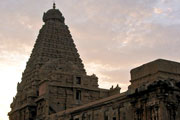 Thanjavur represents South Indian advanced civilization and has now become a World Heritage Site. The art gallery in the Nayak Palace has an impressive collection of ancient bronzes from the Chola period and is known worldwide. The Brihadeeswarar temple, dedicated to Lord Shiva, was built in a record time of 6 years at the end of the 10th century by the Chola ruler Rajaraja I, and is regarded as a sublime masterpiece of Dravidian temple architecture. The site is characterized by its balanced design. After passing two entrance towers guarded by stern-looking dwarapalakas (door guards), the visitor enters a spacious courtyard with the majestic sanctuary at its center. The 16-storey structure above the main chamber is crowned by an 80-ton monolithic dome. After sunset, the temple complex is illuminated by spotlights, emanating an almost mystical atmosphere.
Thanjavur represents South Indian advanced civilization and has now become a World Heritage Site. The art gallery in the Nayak Palace has an impressive collection of ancient bronzes from the Chola period and is known worldwide. The Brihadeeswarar temple, dedicated to Lord Shiva, was built in a record time of 6 years at the end of the 10th century by the Chola ruler Rajaraja I, and is regarded as a sublime masterpiece of Dravidian temple architecture. The site is characterized by its balanced design. After passing two entrance towers guarded by stern-looking dwarapalakas (door guards), the visitor enters a spacious courtyard with the majestic sanctuary at its center. The 16-storey structure above the main chamber is crowned by an 80-ton monolithic dome. After sunset, the temple complex is illuminated by spotlights, emanating an almost mystical atmosphere.
Day 7: Transfer to Madurai – Meenakshi Temple – Highlight of Dravidian temple architecture
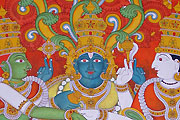 According to mythology, in Madurai, Shiva took his consort Parvati to wife in the form of the beautiful Pandya princess Meenakshi. The Meenakshi temple, built in the 16th century during the Nayak period, represents the late stage of Dravidian temple architecture. Towards the north is the Sundareswarar temple, dedicated to Shiva in the form of Sundareswar, the beautiful lord. Both temples are part of an impressive overall complex which draws the visitor into a mystical world with the bright and colorful decoration of its temple towers, the half-dark colonnades, the traditional processions, the illuminated side shrines and the abundance of mythological motifs. Also worth seeing are the temple museum and the market with devotional items, housed in two large temple halls, where many pilgrims buy their souvenirs. Other attractions in Madurai are the Thirumalai Nayak Palace, built in the 17th century in Indo-Saracenic style, and the Gandhi Memorial Museum.
According to mythology, in Madurai, Shiva took his consort Parvati to wife in the form of the beautiful Pandya princess Meenakshi. The Meenakshi temple, built in the 16th century during the Nayak period, represents the late stage of Dravidian temple architecture. Towards the north is the Sundareswarar temple, dedicated to Shiva in the form of Sundareswar, the beautiful lord. Both temples are part of an impressive overall complex which draws the visitor into a mystical world with the bright and colorful decoration of its temple towers, the half-dark colonnades, the traditional processions, the illuminated side shrines and the abundance of mythological motifs. Also worth seeing are the temple museum and the market with devotional items, housed in two large temple halls, where many pilgrims buy their souvenirs. Other attractions in Madurai are the Thirumalai Nayak Palace, built in the 17th century in Indo-Saracenic style, and the Gandhi Memorial Museum.
Day 8 and 9: Transfer to Thekkady – Spice gardens in the land where pepper grows – Hiking in Periyar National Park
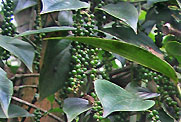 In Thekkady, you are in the land where the pepper grows. The small town is nestled between green tea, coffee and spice plantations in a typical South-Indian hilly landscape. Thekkady is probably the best place for buying Indian spices of the highest quality. On a visit to one of the many spice gardens, the various traditional spices can be directly experienced in nature, under the guidance of a professional. Another attraction is the Periyar National Park, which is among the best-known nature and wildlife sanctuaries in South India. On an early morning hike with local guides or on a boat ride on Periyar Lake, one can – with a little luck – spot elephants and a variety of other wild animals. A visit to a Kalaripayattu demonstration is also an impressive experience, providing insight into the traditional martial art of South India.
In Thekkady, you are in the land where the pepper grows. The small town is nestled between green tea, coffee and spice plantations in a typical South-Indian hilly landscape. Thekkady is probably the best place for buying Indian spices of the highest quality. On a visit to one of the many spice gardens, the various traditional spices can be directly experienced in nature, under the guidance of a professional. Another attraction is the Periyar National Park, which is among the best-known nature and wildlife sanctuaries in South India. On an early morning hike with local guides or on a boat ride on Periyar Lake, one can – with a little luck – spot elephants and a variety of other wild animals. A visit to a Kalaripayattu demonstration is also an impressive experience, providing insight into the traditional martial art of South India.
Day 10: Transfer to Alappuzha (Alleppey) – House boat trip on the backwaters
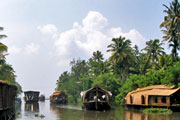 Kerala is famous around the world for its numerous waterways; lined by palms, mango trees and rice paddies, they crisscross the region and are known as the ‘backwaters’. They form a vast network of waterways that extends from Kochi in the north to Kollam in the south, crossing an area of about 2000 square kilometers, consisting of 29 lakes and lagoons, 44 rivers and about 1500 canals. The largest lake, with a length of 83 km, is Vembanad Lake, which is connected to the Arabian Sea. The peaceful backwaters, serving as trade and transport routes for the locals for many centuries, are a spectacular destination for tourists. Discovering the picturesque water world on a house boat trip is an unforgettable highlight of a trip to Kerala. The romantic boats, providing all meals and comfortable accommodation for the night, are converted former rice barges. Your backwater trip starts and ends at the Alappuzha (Alleppey) boat jetty.
Kerala is famous around the world for its numerous waterways; lined by palms, mango trees and rice paddies, they crisscross the region and are known as the ‘backwaters’. They form a vast network of waterways that extends from Kochi in the north to Kollam in the south, crossing an area of about 2000 square kilometers, consisting of 29 lakes and lagoons, 44 rivers and about 1500 canals. The largest lake, with a length of 83 km, is Vembanad Lake, which is connected to the Arabian Sea. The peaceful backwaters, serving as trade and transport routes for the locals for many centuries, are a spectacular destination for tourists. Discovering the picturesque water world on a house boat trip is an unforgettable highlight of a trip to Kerala. The romantic boats, providing all meals and comfortable accommodation for the night, are converted former rice barges. Your backwater trip starts and ends at the Alappuzha (Alleppey) boat jetty.
Day 11: Transfer to Kochi (Cochin) – Cultural diversity on the Malabar coast
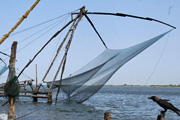 The port city of Kochi, formerly known as Cochin, is uniquely located between the Arabian Sea and the backwaters. With its rich ethnic and cultural heritage, Kochi’s atmosphere is an unforgettable experience. A variety of attractions offer insights into the rich history of the city, characterized by strong Portuguese and Dutch influences. Particularly interesting is a visit to Mattancherry and Fort Kochi, the historical city with its bustling life. Among the attractions for which sufficient time should be reserved are the winding streets with old Dutch houses, Chinese fishing nets at the waterfront, traditional spice markets, the antiquities quarter, the Jewish synagogue, the Mattancherry palace with its exquisite mythological murals and the St. Francis Church, built in 1503, where Vasco da Gama was buried until his remains were transferred to Lisbon in 1539. A special cultural attraction is the spectacular Kathakali dance theater. There are performances every evening.
The port city of Kochi, formerly known as Cochin, is uniquely located between the Arabian Sea and the backwaters. With its rich ethnic and cultural heritage, Kochi’s atmosphere is an unforgettable experience. A variety of attractions offer insights into the rich history of the city, characterized by strong Portuguese and Dutch influences. Particularly interesting is a visit to Mattancherry and Fort Kochi, the historical city with its bustling life. Among the attractions for which sufficient time should be reserved are the winding streets with old Dutch houses, Chinese fishing nets at the waterfront, traditional spice markets, the antiquities quarter, the Jewish synagogue, the Mattancherry palace with its exquisite mythological murals and the St. Francis Church, built in 1503, where Vasco da Gama was buried until his remains were transferred to Lisbon in 1539. A special cultural attraction is the spectacular Kathakali dance theater. There are performances every evening.
Day 12: Leisurely stroll in Kochi (Cochin) and return home or travel onwards
In the morning, there is time for a further exploration of Kochi. The unique location between the Arabian Sea and the backwaters invite the visitor to go on a tour of discovery using the local ferries, the main means of transportation between the various parts of the city. In this way, one can explore the port, the islands and the modern district of Ernakulam. Also recommended is a leisurely stroll through the antique and spice markets, which is concluded with a lunch at one of the many restaurants in the old town.
In the afternoon or evening, a transfer is made to the train station or airport to return home or travel onwards.
